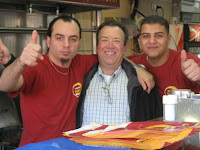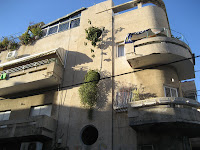 On Sunday, 18 Jan 2009, we started our day at cousin Marcia's Hadassah chapter meeting where Liz and I were the featured speakers. The topic was why we are Zionists and what we do during our Winters in Israel. After sharing our personal stories about how we got here, Liz described her volunteer work and how her working has led to my being able to show up and eat.
On Sunday, 18 Jan 2009, we started our day at cousin Marcia's Hadassah chapter meeting where Liz and I were the featured speakers. The topic was why we are Zionists and what we do during our Winters in Israel. After sharing our personal stories about how we got here, Liz described her volunteer work and how her working has led to my being able to show up and eat.After the Hadassah ladies finished with us, Liz took me to La Soba. In past years she's kept this place to herself on the grounds that I can't be on my feet for 2 to 4 hours at a time. But I've been doing well of late and Liz knew that the soup kitchen would be short on volunteers, so I got drafted. La Soba is located in the Shapira neighborhood, tucked in between Hatikvah and South Tel Aviv. For those of you who know NYC think of the sketchier, industrial sections of the outer boroughs, particular that area of Queens that seems to consist mainly of legal auto body and not so legal auto chop shops. La Soba gets its food donated from local restaurants and serves anyone who walks in the door and sits down. There is no official take out service but some people know that if they come in with a container they will get food to take home, which may be the park or a local shelter.
Working at La Soba is something like being Lucy in the bon bon factory (or, for you younger Suspects, Gilda Radner in the nuclear warhead factory). Three of us were loading trays for other workers to serve to diners. The concept is to provide free meals while preserving people's dignity. The clientele is a diverse mix of poor people, illegal immigrants, drug users and dealers, crazy people who fell through holes in the social safety net and people who are just plain hungry and know how to find the place. A "you-name-it-we-got-it" sort of crowd. The workers include volunteers from all walks of life, like the head of health services for the Israel police or one of the first pilots in the Israel Air Force or my Wife, and a variety of convicts working off their community service sentences. If your Hebrew is good enough you can not only have the pleasure of performing a real mitzvah but also learn how to embezzle from your company, cheat on your taxes or steal bicycles. Getting into the flow of the place, I started singing (to myself) every depression era food song I could remember (Soup and Pie in the Sky kept coming up to the frontal lobe). Liz works there most Sundays and I'm going to join her.
After La Soba we had to make the major decision of where to eat lunch. Since we were already in the sketchy end of Tel Aviv we were within an easy walk of Gina's Felafel. Gina's would not be the almost mythical Arab falafel that Liz keeps searching for. One of the Arab kids working off his sentence at La Soba recommended Itzik's on Jerusalem in Jaffa, not to be confused with Big Itzik's grilled meat in the outer fringe of the flea market, but we decided that would be too far out of our way. We'll try Itzik on another day and I will duly report our findings.
 Gina's turned out to be more than satisfactory. At least as good as the kiosk on Nordau, the falafel was fresh and tasty. The guy behind the counter treated me like an old friend (see the picture) and the restaurant, including the bathroom, was remarkably clean. We sat outside and watched the traffic go by, trying to puzzle out why we seem to have an affinity for places where real people, as opposed to tourists, hang out. (Disclosure: This may end soon as Gina's made it into this month's Time Out Tel Aviv.) Everyone but us looked like they were on their lunch break, except the couple strolling by who were dressed like they had seen too many Quentin Tarrantino movies (he had half his body weight in grease on his hair, both were visions in black and white). The only way they will avoid capture by the fashion police will be if they were scouting locations for their film company. Which would not be unusual as Tel Aviv streets host numerous fashion photo shoots, TV news broadcasts and Indie film crews.
Gina's turned out to be more than satisfactory. At least as good as the kiosk on Nordau, the falafel was fresh and tasty. The guy behind the counter treated me like an old friend (see the picture) and the restaurant, including the bathroom, was remarkably clean. We sat outside and watched the traffic go by, trying to puzzle out why we seem to have an affinity for places where real people, as opposed to tourists, hang out. (Disclosure: This may end soon as Gina's made it into this month's Time Out Tel Aviv.) Everyone but us looked like they were on their lunch break, except the couple strolling by who were dressed like they had seen too many Quentin Tarrantino movies (he had half his body weight in grease on his hair, both were visions in black and white). The only way they will avoid capture by the fashion police will be if they were scouting locations for their film company. Which would not be unusual as Tel Aviv streets host numerous fashion photo shoots, TV news broadcasts and Indie film crews. After lunch we decided to walk up to the Shalom Tower (once the tallest building in the Middle East but now dwarfed and hidden by taller and even uglier sky scrapers). The galleries on the first two floors of the Shalom Tower currently feature exhibits relating to the 100th anniversary of Tel Aviv. (Burt - sorry we missed this) If you're on foot, you get from South Tel Aviv to the Shalom Tower by going through the Florentin. The Florentin by day is a collection of furniture shops (making, repairing, selling), printers and wholesale clothing stores. By night it features some of the newer, hipper and more underground art galleries, cafes and clubs in town. The area is a bit run down (part of the bohemian charm) but features this city's International Movement architecture (think Bauhaus, Corbusier, Van Der Rohe and their progeny). (See picture attached)
After lunch we decided to walk up to the Shalom Tower (once the tallest building in the Middle East but now dwarfed and hidden by taller and even uglier sky scrapers). The galleries on the first two floors of the Shalom Tower currently feature exhibits relating to the 100th anniversary of Tel Aviv. (Burt - sorry we missed this) If you're on foot, you get from South Tel Aviv to the Shalom Tower by going through the Florentin. The Florentin by day is a collection of furniture shops (making, repairing, selling), printers and wholesale clothing stores. By night it features some of the newer, hipper and more underground art galleries, cafes and clubs in town. The area is a bit run down (part of the bohemian charm) but features this city's International Movement architecture (think Bauhaus, Corbusier, Van Der Rohe and their progeny). (See picture attached)The Shalom Tower exhibits include quilts depicting scenes, current and historic, of Tel Aviv. Its painting using textiles. The colors just jump off the walls and the City comes to life. Add to this the murals made from tiles, the still photographs and films of the founding of the City (a lottery to distribute building plots held on a sand dune where Rothschild Boulevard now runs), the architecture and the seaside and large model of the City celebrating its status as a UNESCO historic site (a/k/a The White City), and we had a couple of hours of free entertainment.
Next we strolled into Neve Tzedek, the first neighborhood built outside Jaffa and now the capital of Israel's yuppy gentry. Our goal was something chocolate and gooey, washed down with cappucinos, to top off the falafel lunch. This was accomplished at Susannah's, a trendy cafe next to the Suzanne Dallel Dance Center, which lives in a couple of rehabilitated trade school buildings saved from the wrecking ball to anchor the revitalization of the neighborhood. This year's location puts us within easy walking distance of Neve Tzedek and Jaffa so we should have more to tell (like the wine bar featuring only Israeli wines).
And then walking back home along the beach (I have mentioned the beach, haven't I?) to turn on the TV and internet to learn if the war was still over for now.
A SAD NOTE
During Sunday's wandering my brother, Bill, called to tell me that our cousin, Steven Levitin, who's cardiomyopathy had been discovered when he was 2, led an exemplary life but was, in the end, done in by his own body. His cardiomyopathy blocked the output from his left ventricle (mine does not which is probably why I'm writing this and he's not) and he spent the next 50+ years watching his diet, exercising carefully, taking tons of drugs and, nine years ago, having a heart transplant. Most people, especially his parents will tell you that he died way too young. Steven, though, will tell you that by being careful and by having really great medical care he was lucky and probably added two or three decades to his life. Steven was always upbeat and always felt he would walk away from his latest crisis. He was looking good and feeling optimistic when I saw him last July. In the Fall he had a heart attack (apparently his old arteries failed his new heart). Before I left for Israel I spoke to him. Steven was still in the hospital while his doctors debated putting him back on the transplant list. Steven was looking forward to walking out of there yet again. He didn't this time.
Steven was always someone who worried about everyone else and put a lot of energy into helping others. I like to say that you can tell a man by his wife and children. Lord knows I get forgiven for my multitude of sines because people really like Liz and the girls. Steven leaves a wonderful wife, Kathleen, and two daughters, Rachel and Hillary, whom anyone would be proud of. A fitting legacy for a decent guy who, despite what he would say, left us too soon.




No comments:
Post a Comment